 Ok. This is the last turn of the game. Although I am playing with several players who seem to understand how this game works as much as they do quantum physics, I have managed to stay in second place. No one has invested in *insert random resource here* like I have, so if I go there I should pull out the vict- wait, what…why did Billy go there… *Random resource* doesn’t even help him or score him any points….. I HATE WORKER PLACEMENT GAMES….. I flip the table, or at least I do in the bliss of my vivid imagination.
Ok. This is the last turn of the game. Although I am playing with several players who seem to understand how this game works as much as they do quantum physics, I have managed to stay in second place. No one has invested in *insert random resource here* like I have, so if I go there I should pull out the vict- wait, what…why did Billy go there… *Random resource* doesn’t even help him or score him any points….. I HATE WORKER PLACEMENT GAMES….. I flip the table, or at least I do in the bliss of my vivid imagination.
I love worker placement games, but I hate when I have a plan and a player places a worker, always randomly, at least in my mind, on the space I want. I would love to just flick his worker like I was playing Pitch Car…or better yet, assassinate the worker.
If you have ever had a train of thought similar to that while playing a worker placement game, then Deadwood just might be the game for you…
Deadwood is a “wild west” themed worker placement game for two (really three, but more on that later…) to five players that plays in between 30 to 60 minutes. Deadwood plays best with 4-5 players.
Game Overview:
The object of the game is to have the most money when the game ends. During each turn, the player must choose to either return one or more of their cowboys from the game board to the ranch (resources available to the player) for use on his next turn, or to deploy a cowboy to one of the buildings to “annex” the building to use its special ability, usually earning money and/or allowing the use of a special action. The catch is that, unlike most worker placement game, if someone else’s cowboy is on a space you desire, you can try to force your way onto the space, causing a shootout to resolve who has the rights to the building and who is taking a dirt nap.
Components:
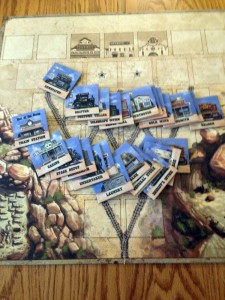
The game comes with a board, eight dice for shootout simulation and gold mine resolution, and many cardboard tokens representing the cowboys, buildings, money, ammo, etc. The board is good for what it is – a place to play the game. The art is sparse, but it has to be because only three of the available buildings are printed on the board. The rest of the spaces are empty, but will be populated by buildings (five randomly during setup and the rest during the game) as the game progresses.
The dice are OK. They are wooden and they are dice. For full disclosure, the dice I received were not uniform (some had different shading), but that did not bother me. If that would bother you, I would recommend replacing them. My guess is that, if you are like me, you have many six sided dice in your collection!
The cardboard tokens are really nice. I particularly liked the thickness of the tokens. I also liked the art on the buildings as well as the iconography utilized in the game. This is not Race for the Galaxy. After a game or two I did not need to pull out the rulebook to remember what an icon represents. Overall, I felt the components were decent to good, especially the cardboard tokens.
How to Play:
At the start of the game, each player receives one cowboy of each level of strength (all cowboys have a strength of one, two, or three). The other six cowboys, two of each level of strength, can be recruited from the supply during the game. In addition, wanted posters equal to five times the number of players are placed in the Crime Pool next to the board. Wanted posters, given to players who initiate a shootout, are one of the end game triggers.
Each turn, a player can choose one of two actions to take:
- Place one cowboy on a building on the board
- Return one or more of their cowboys back from the game board to their ranch
Placing cowboys: If the building is unoccupied, the player immediately receives the benefit the building provides; however, if the building is already occupied, a shootout occurs.
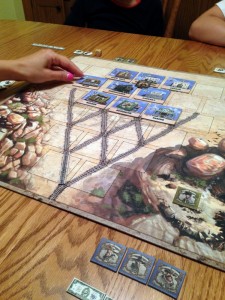
Shootouts: The attacker receives a wanted poster (a player receives negative points if he has any wanted posters when the game ends) and the defender needs to decide if he is going to stand his ground or discard a pony token to flee on horseback to the abandoned mine. The cowboy in the abandoned mine board will not return to a player’s ranch until the next “return cowboys home” action is taken.
If the defender remains, the attacker must declare if he is going to discard one ammo token to add to his die roll, followed by the defender making the same declaration. Then the available dice for each player are determined by adding the cowboy’s strength to the ammo, if ammo was declared to be used. If one side has more dice than the other, the player rolls the number of dice that they have that is greater than their opponent. A six is an automatic kill, a four or a five is a wound, but two wounds is a kill.
If the attacker fails to kill on the initial die roll, or if both players had the same number of attack dice, then both the attacker and defender simultaneously roll their remaining dice and determine if neither, one, or both cowboys are eliminated. If no one dies, the attacker goes to the abandoned mine, but does not have to discard a pony token. If a cowboy dies, be it attacker or defender, they are placed in the graveyard and are permanently out of the game (no resurrections in this town!!). If the attacker survived, they immediately utilize the building’s special ability. If both players die, the building is left unoccupied for the next entrepreneurial cowboy.
Note that a player cannot stack cowboys on the same building to protect it. There is a strict limit of one cowboy per building.
Return cowboys to the ranch: A player returns one or more of their cowboys from the board (except the graveyard…seriously…those guys are DEAD) and takes them back to his ranch. This action will be necessary because, at some point, all of your cowboys will be on the board and you will have no way to claim a building. The key to this action is that the player does not have to return all cowboys to his ranch. Key buildings can be guarded by a player’s cowboys, forcing other players to fight him for the space later in the game (and draw the undesirable wanted posters).
After the turn is over, the player to his left goes, and this is repeated until the game is over. There is no starting player space or a way to change turn order in Deadwood because no such space is needed.
The game ends when one of three end game conditions trigger, listed in order of most to least common, at least in my experience:
- The Train Station building is placed on the board
- There are no more wanted posters in the Crime Pool
- A players has no more living cowboys on the board or their ranch
The winner is the player with the most money, less the monetary penalty for wanted posters in his ranch at the end of the game. If there is a tie, there is a final shootout to determine the winner!
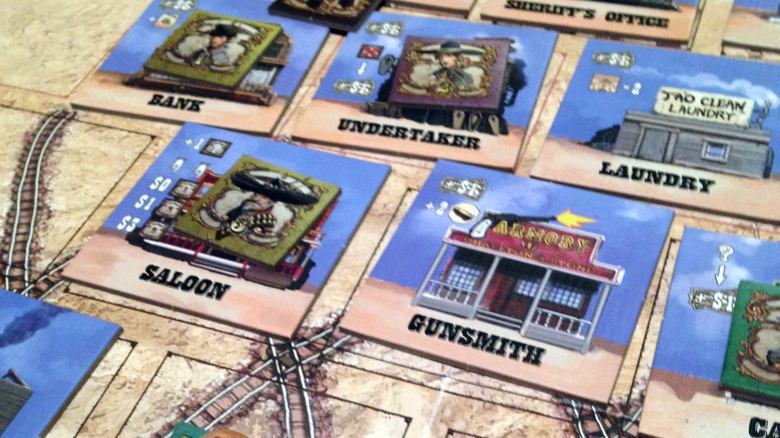
Game Experience:
Deadwood is a light game. There is strategy, but this is not Le Havre. What the game lacks in strategic depth, it more than makes up for in three important factors: fun, replay value, and length of play time.
Fun: No more using the excuse of “I would have won if you hadn’t taken all the food from that space.” In Deadwood, you can try to eliminate the player on the space that you want. Of course, the rest of the table will laugh at you if your three strength cowboy is taken out by your opponent’s one strength cowboy. Not that I know from experience…
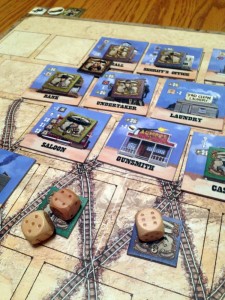
The buildings are interesting and provide several different game play options. There are a total of 21 unique buildings included in Deadwood (note that five of the buildings have duplicates to make sure there is not a way to keep a chokehold on specific buildings, like the Saloon, for example). Some of the buildings include:
- Sheriff’s Office – allows the player to move the sheriff, who is placed on the intersection of three buildings. NO shootouts can occur at these three buildings, and, if a player wants to place a cowboy in a building that is protected by the sheriff, they must pay money to the current occupant of the Sheriff’s Office.
- Saloon – the place to recruit more cowboys for your gang
- Church – the only building that multiple cowboys can occupy. There cannot be a gunfight at the Church, but you can remove one of your wanted posters from the game. The wanted poster does not go back to the Crime Pool established at the start of the game.
- Blacksmith – provides more ponies for the yellowbellies
- Gunsmith – provides more ammo for killing. There are not many pacifists in the Biewer family, so we enjoyed many gunfights outside of the Gunsmith!
- Bank – players can rob the Bank for a significant amount of money, but they must take a wanted poster as a consequence
As you can see, there are many different buildings to consider and different actions that can be performed. What I found especially appealing was how well the theme was tied to the actions provided by the buildings. The Newspaper allows you to give another player a wanted poster. The Gold Mine makes you roll dice to see how much money you make. The Grifter provides the occupant an opportunity to move any two cowboys to the abandoned mine. I really enjoyed all of the special actions provided by the buildings, both thematically as well as from a game play perspective.
Replay Value: I found this game highly replayable. The buildings are randomly placed face down in stacks one, two, or three, as dictated by the face up side of each building, at the start of the game. Through actions performed at the Town Hall or Stage Depot, additional buildings are placed on the board, and are placed adjacent to existing buildings, but at the discretion of the current occupant. This creates a new layout for the town every time the game is played. This is important because if three high traffic buildings are placed adjacent to each other, the Sheriff’s Office will become more valuable.
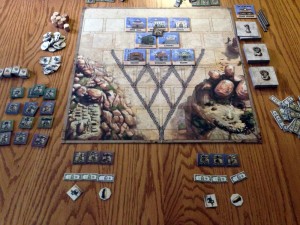
In addition, the endgame is random and adds to the replay value. Players can attempt to manipulate when the game comes to an end. They could start printing wanted posters at the Newspaper if there are only a few wanted posters left in the Crime Pool. Occupying the Town Hall allows the placement of a railroad tile. There are four railroad tiles that need to be placed (destroying any buildings that are on a space where the railroad is built). After the fourth railroad tile is placed, the next time the Town Hall is used for its action, the Train Station is placed and the game ends.
Finally, if an opponent is down to one cowboy, the option is available to attack the cowboy to, hopefully, end the game.
Length of Play Time: I really appreciated Deadwood’s game length. It plays fast and with very little downtime. I seemed to be constantly doing something, be it taking my turn, defending myself from an attacker or laughing at/with the others who I was playing with. As the number of players increase, so does the game length, but nothing unbearable. Our longest four player game went about an hour. (Note: The only player count I did not get to experience is five players).
The only player count I would not recommend is two players. I played multiple two-player games and there were a couple of instances where combinations of certain buildings essentially locked down the board from one of the players. I never experienced this in any of the three or four player games that I played.
Final Thoughts:
I really enjoyed this game. To be honest, I was not expecting much from Deadwood. I thought it would be an OK game. I was expecting the game to be random and crazy, and it definitely is random and crazy.
What struck me the most was how much fun I had playing the game. The shootouts are entertaining, and as random as die rolls can be, the luck can be partially addressed by using higher strength cowboys and ammo to increase the number of dice rolled. How quickly the game moves also impressed me. Even with one of my regular AP prone players (my wife), the game moved quickly. Finally, I was pleasantly surprised by the theme and how well it was tied to the game. I cannot explain it well in words (which sucks for a written review), but the way the game actions were tied to the buildings just made it feel Wild Westy (I know that isn’t a word).
At the end of the day, regardless of theme, depth, or game length, what matters most to me is how much fun I have. And I had plenty of fun playing Deadwood.
If you are interested in getting a copy for yourself, it seems to be out of print, but there are some second hand copies available.
Final Score: 4 Stars – A light, fun and confrontational worker placement game that is easy to each and a blast to play.
 Hits:
Hits:
• A worker placement game that allows you to attack people who take the building you want. YES!
• Easy to teach with a relatively quick playtime
• The Wild West theme is well represented in this game.
Misses:
• Might be too random for die-hard worker placement fans.
• Not good as a two player game





















